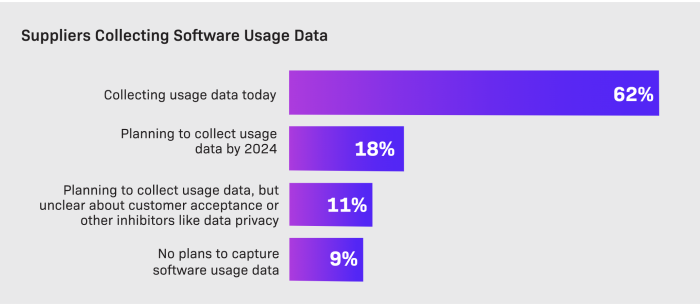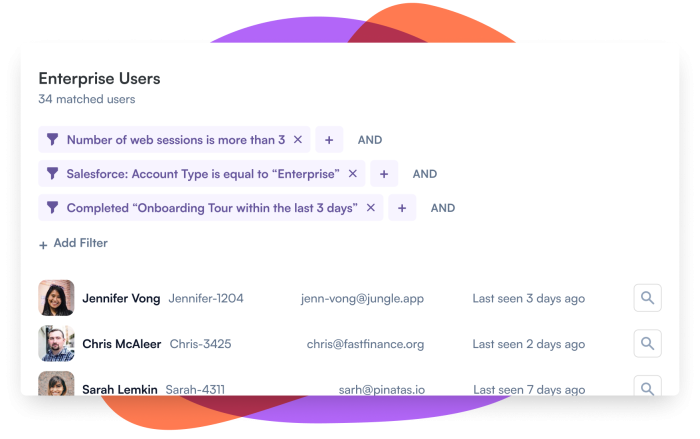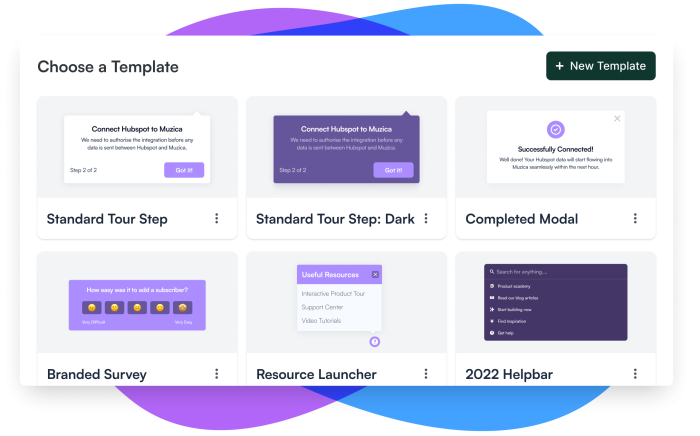What do doctors, financial analysts, and product managers have in common? They all look into hard facts and analytics when making decisions, and they all avoid guesswork at all costs.
Imagine if your doctor went off gut instincts to diagnose your medical condition, or your financial analyst invested your money based on intuition. A ticking time bomb—with important ramifications.
A product company faces a similar chaotic situation if product managers design the user experience and introduce new features based on hunches. The result: customers that feel increasingly disconnected and frustrated, ultimately giving up and switching to a competitor.
Is there an antidote for this user experience guesswork? Yes: analyzing product usage data. Let's discuss how it can improve your strategic decision-making and help you maximize user success.
Product usage studies how users interact with your product and offer meaningful insights for improving the user experience.
Insights from product usage data can help you identify behavioral patterns for different user personas, guide iterations in your roadmap, and enhance features, among other benefits.
Some of the key product usage metrics, like time-to-value, onboarding success rate, engagement score, and time spent using the product, highlight your product’s value for the users.
Product usage data enables you to accelerate user activation, increase free-to-paid conversions, personalize the user experience, and build customer loyalty.
What is product usage?
Product usage is the study of user behavior and activity within your product. It tracks and analyzes how users navigate your product interface and use different features. This data offers a wealth of knowledge to understand the product experience and make informed decisions to drive product adoption.
Collecting user feedback through in-product surveys and user interviews is a surefire way to recognize customer pain points and concerns, but it only gets the job half done. Product teams need to dig deeper by observing how users interact with your product, for how long, and for what purpose.
Without product usage analytics, you’re taking a shot in the dark and leaving money on the table (for your competitors!). Let’s understand why product usage is one of the core product management KPIs and how it can turn customers into product champions.
How product usage data influence your product lifecycle
Measuring product usage gives you complete visibility into in-product user behavior. You can identify points of friction, most used features, engagement drivers, and reasons for churn.
Put simply, you get a 360-degree view of your user experience with insights into what's working and what needs improvement.
As the insights from the Revenera Monetization Monitor show, 80% of product managers either actively collect usage data or plan to gather it by 2024.

Source: Revenera Monetization Monitor Report
Why is this important? On top of giving you an in-depth view of your user journey and experience, product usage data offers many other benefits. Let’s take a closer look at these.
Identifying behavior patterns
Behavioral analytics enable you to stay one step ahead of your customers and reveal unique insights. You can refer to this data to understand every user's product knowledge, skill level, jobs to be done, and overall efficiency. This enables you to customize your interface and design better features matched for different types of users.
Adjusting product roadmap
Guesswork hinders your product development efforts. You're unsure of what your users truly want—meaning you’re forced to change gears frequently to roll out new features and modify existing ones to incorporate user feedback.
With data-backed awareness of your customers' needs, you can create an informed product roadmap that takes user experience and product usage insights into account. You can also iterate this roadmap to deliver a more streamlined experience and boost activation, retention, and user engagement.
Refining your features
At the core of every product strategy lies the need to set your users up for success.
Product teams always aim to reduce friction and improve the product's efficiency. Measuring usage data unlocks the exact information they need to map the scope of improvement.
If you’ve already planned to create advanced features, feature usage data will tell you whether your ideas are aligned with your users’ aspirations.
Improving the user experience
The most direct benefit of measuring usage data is enhancing the user experience and boosting customer satisfaction.
This quantitative and qualitative data identify your users' concerns and challenges within the app. It also helps you recognize opportunities for upsell and revenue expansion by identifying how users engage with your product.
Fix every shortcoming within your product and tap into expansion opportunities to keep customers happy and grow your revenue consistently.
What tools to use to extract product usage data
Now that we’ve discussed the main reasons why you should measure product usage, the bigger question is: how to track usage frequency and behavior?
A product analytics tool is a must for tracking this usage data. An analytics tool studies user behavior to create detailed reports on how you’re faring, what needs work, and more. Popular choices for product analytics include:
Heap: Ideal for analyzing user onboarding flows and personalizing the user experience
Mixpanel: Ideal for product usage segmentation, user journey mapping, and analyzing new features
Amplitude: Ideal for event tracking, real-time data collection, and predicting different events like churn
When you integrate your analytics tool with Chameleon, you can collect more granular insights on user behavior. This integrated setup will also scope the opportunities for upgrading the product experience to increase your conversion rate.
💡 Remember: Solely relying on quantitative data won’t cut it. Combine it with in-app surveys, UX research, and user testing to get qualitative insights for product usage and make educated decisions.
8 key product usage metrics to track consistently
Every product team will have its own metrics to assess product usage and enhance performance. Here are eight popular product usage metrics to consider for your SaaS:
Churn rate: The percentage of users who stop using your product and cancel their subscriptions—often because they don't find value anymore. A high churn rate typically signals the need for improvements in your product.
Retention rate: The percentage of users who continue to use your product in a given period. Retention is the key to unlocking higher product usage and increasing customer lifetime value.
Feature usage: Identifies the most popular features and calculates the feature adoption rate. It also helps you identify lesser-used features that need a facelift for improved usage.
Time-to-value: The amount of time it takes users to realize your product’s actual value and reach the aha! moment. Quicker TTV indicates your product’s effectiveness in helping users find the tools they need to fulfill their goals quickly.
Usage frequency: Refers to how frequently users engage with your product—whether that’s daily, weekly, or monthly. A high number of daily or weekly active users means your product meets buyers' needs.
Engagement score: Measures how engaged users are with your SaaS. This metric is a combination of various factors, like usage frequency, time spent on the app, renewals, integrations, etc., to determine individual user engagement.
Onboarding success rate: Calculates the number of users completing the onboarding flow successfully. This metric highlights any red flags in your onboarding process that pushes users to drop off without finishing it.
Time spent using the product: The average time users spend on your SaaS in a single session, daily, weekly, or monthly. Depending on your product’s use case, time spent tells you whether your product is helpful or problematic. For instance, if you have an automation tool, the more time users spend on the app, the more frustrating it can be for them.
With these core product usage metrics, you can think about feature development, bug fixes, and your overall customer experience more strategically. And we’re just about to tell you how.
How to create segments based on product usage data
You can use segmentation and cohort analysis to make your behavioral analytics framework more insightful. Cohort-based segmentation pinpoints visible patterns in your usage data and creates cohorts of users with similar characteristics.
For example, you can build user cohorts based on behavioral characteristics taken from your product analytics tool. These cohorts could be first-time users, weekly active users, power users, and similar.
With these cohorts, you can make your onboarding flows, product tours, and in-app guides behavior-driven and deliver more targeted messaging at every stage.
Here’s an example of how you can use different segments in Chameleon to target the right user cohorts with the right in-app messages at the right time.

You can create custom user segments based on multiple attributes, be it demographic, behavioral, needs-based, or other factors.
Divide your users based on your key metrics—like usage time, feature usage, retention, and more—to see how each cohort is adopting your product and review your performance.
Then, create a more user-centered design, achieve better product alignment, and optimize your positioning.
How to increase retention with product usage insights
Product usage insights provide concrete evidence of what users expect from your SaaS and growth opportunities. We’ve detailed four key use cases to help you make the most of your product usage data.
Use the insights to activate users more quickly
The key to activating users quickly lies in understanding what matters to them. Creating segments based on product usage data tells you exactly that and helps in designing personalized activation milestones based on users' in-app preferences and patterns. It also gives you an overview of the total number of users to have completed the process, revealing where most users dropped off.
You can use these insights to identify the specific features that offer maximum value to different user segments. Then, define tailored milestones to help them recognize this value from the start.
The result? When new users feel excited to complete the onboarding flow and these milestones, it’ll effectively drive up your activation and adoption rates.
Integrating a product adoption platform like Chameleon into your product analytics process lets you track users as they pass through activation and offer contextual help to encourage them to complete the remaining steps.
How does it work? Each in-product experience you create with Chameleon has a step ID connected to it, so you can also track step-level events. Based on this monitoring, you can send helpful nudges such as tooltips, product tours, or feature walkthroughs to encourage users to complete the activation and continuously discover more value in your product.
With Chameleon, you can build these within minutes by creating your own from the scratch or starting with one of the templates. Here are only some that can help you get started quickly.

Drive more free-to-paid conversions with data-backed insights
One of the critical metrics you need to consider for increasing your free-to-paid conversion rates is the average time it takes a user to get habituated to your product.
When you know how much time free users need on your app before realizing its complete value, you can maximize conversions from your free trial. However, habit formation is only one aspect of converting free users to paying customers.
Usage insights will also reveal the most impactful features that differentiate your product from competitors. Identify these features for the free trial to build product stickiness, giving users all the reasons they need to pay for a subscription.
You can also separate the activated users from the inactive ones and focus more on the former. Add them to your product-qualified lead (PQL) pipeline and nurture them with sales calls, discount offers, self-service resources, and other tactics. The goal is to remove all friction points from their experience and boost user success to convert these users.
Customize in-app messages to in-product user behavior
Done right, personalization can be a game-changer for product companies. After all, you could potentially generate 40% more revenue by personalizing the user experience.
You can level up your personalization efforts and deliver more relevant messaging to each user persona with product usage data. Map the entire user journey and identify areas where users might need additional help. You can also pinpoint opportunities for engaging users with promotional offers or in-app notifications.
Refer to your product usage insights to find out the friction points, and create self-serve resources for features that tend to trip users up. These insights can also be used to program your product adoption platform for improved messaging and personalization.
Retain more customers, minimize churn, and build loyalty
Measuring product usage gives you a realistic pulse of your customers. You can recognize satisfied customers and increase their lifetime value with upsell and cross-sell opportunities.
More importantly, you can identify unhappy users at risk of churning. Getting this information is the starting point for improving your retention efforts.
When you identify the sign of churn by comparing segments and users, you can increase user engagement and offer proactive support to help them discover the product’s value. Pay close attention to high-risk customers and guide them to navigate your product better.
Plus, you can also rely on product usage insights to streamline and enhance the experience for satisfied customers. Refer to customer retention metrics to drive your growth. Consistently eliminate friction, collect user feedback, and introduce feature enhancements to win long-term customer loyalty.
Unlock your product’s full potential
Think of product usage data as the GPS for your SaaS business. It keeps you one step ahead of your users, helps make informed decisions, and guides you in the right direction to reach your goals.
Without these insights, you’re guessing your customers’ needs and building your product blindfolded.
Use the tips in this article to unlock the endless benefits of product usage data and set yourself up to boost your bottom line, maximize retention, and design a seamless user experience. It’s well worth the effort.
Streamline your data flow
Integrate your modern data stack with Chameleon for a streamlined flow of data between your tools, personalize the in-app guidance, and see your product adoption rates go high!





